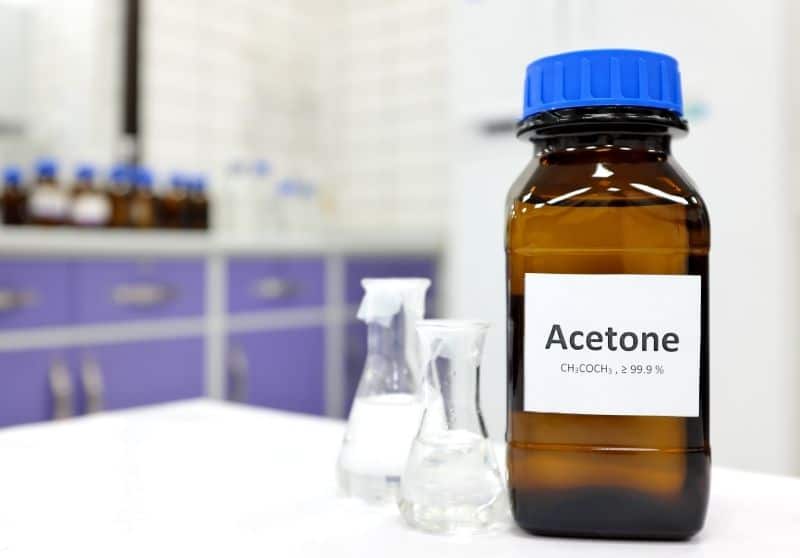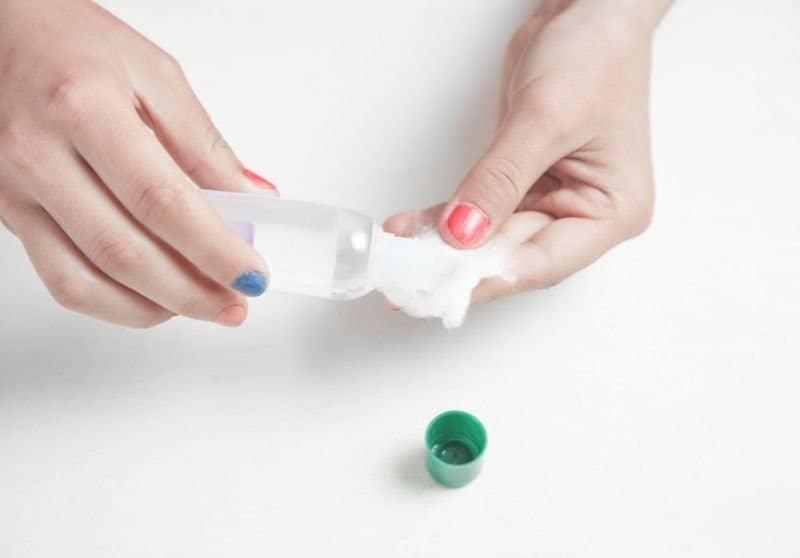Acetone is one of the main ingredients in nail polish remover. Does acetone remove hair dye, also? Read on to find out below.

Acetone is a colorless solvent that can remove hair dye. It’s commonly found in nail polish remover and can break down and dissolve dye molecules. However, acetone isn’t the best way to remove hair dye as it causes dryness and adverse scalp reactions.
What Is Acetone?
Acetone, also known as propanone, is a colorless, odorless, flammable solvent that can dissolve other products.
This explains why acetone is the main ingredient in nail polish and paint remover.
Acetone is also used in the beauty industry to remove hair extensions by dissolving the glue. Acetone is a ketone that occurs naturally in the body in small amounts as a by-product of the breakdown of fat.
It also occurs naturally in the environment.
This chemical is harmless in small amounts, but it can lead to acetone poisoning if ingested. In addition, acetone exposure can irritate the skin, eyes, and nose.
Is Acetone Bad For Hair?
Acetone is a powerful solvent that will strip your hair of its natural oils, leaving it excessively dry.
Therefore, applying acetone to your hair is never a good idea. In addition, prolonged contact can cause skin burns, so you can damage your scalp’s health by using acetone.
For instance, acetone can cause contact dermatitis, characterized by redness, cracking, and extreme dryness.
Although acetone doesn’t break down hair proteins, it can still weaken the hair by removing the natural protective lipid layer.
In addition, acetone has a negative effect on the cuticle layer of the hair shaft.
After applying acetone, the solvent quickly evaporates, leaving the cuticle to dry out and lift. As a result, the hair shaft can no longer trap moisture, making your hair brittle and prone to breakage.
The hair fibers will also feel rough and look dull.
Does Acetone Remove Hair Dye?

Acetone can quickly remove hair dye because it’s a strong solvent. Solvents dissolve other materials, so the acetone removes hair dye by dissolving it and making it easier to wash off.
Both the acetone and dye molecules are charged, so they attract each other.
The interaction between the two molecules is strong, and new bonds are formed, which allows the dye molecules to dissolve in acetone.
This is why acetone is one of the top suggestions for removing hair dye stains from skin, carpets, or furniture.
All you have to do is add nail polish remover (which contains a high amount of acetone) to a wet cotton ball and rub the spot with the hair dye stain.
The stain should come off easily, after which you rinse the area thoroughly.
However, it’s best to avoid using acetone on your hair for several reasons:
- It’s flammable. Be careful when using acetone as it is highly flammable. You can avoid this risk by using other hair dye removal agents.
- It’s harsh on hair. Acetone is one of the harshest substances you could put in your hair. It’s a dehydrating agent that dries your hair terribly and could damage hair.
- It irritates the skin. Acetone can irritate the delicate skin around your scalp.
- May not react well with hair dyes. Acetone may not react well with hair dyes or any substance containing oxidizing agents, such as peroxides, reducing agents, or organic acids.
Generally, it’s best to avoid acetone if you want to remove hair dye from your hair safely.
Acetone is safe to use in small amounts, but you would need to soak your hair in acetone to remove hair dye evenly, and, as mentioned, this is too damaging and harsh for your hair and skin.
How Can You Remove Hair Dye Without Acetone?
If acetone is not the best hair dye removal agent, what can you use to fade hair color?
There are several gentler methods that may take longer but will be healthier for your hair:
- Vitamin C. Vitamin C is ascorbic acid, and there are anecdotal claims that it can help lighten your hair by a shade or two. Crush several Vitamin C tablets and mix with water to form a paste. Apply the paste to hair and leave it in for a while before rinsing.
- Lemon juice. Lemon contains a high concentration of citric acid that’s said to lighten hair naturally. This effect may be more pronounced if the hair is exposed to the sun after applying the lemon juice.
- Baking soda. Baking soda can scrub off dye molecules that adhere to hair fibers. Its high pH also lifts the cuticle, allowing dye molecules deposited inside to escape.
- Clarifying shampoo. Clarifying shampoo has a stronger formulation than regular shampoo. It contains a high concentration of detergents that remove more dye molecules from your hair so that your color fades faster. Dandruff shampoo also has the same effect. For quicker results, you can mix the shampoo (make sure it’s not color-safe) with vitamin C tablets or baking soda.
Other DIY hair lightening methods include Dawn dishwashing liquid or a bleach wash.
All these methods remove hair dye over time but will not restore your hair to its natural color.
Always follow up with a moisturizing treatment when using these methods to remove hair dye to minimize damage and improve hair health.
How To Use Acetone To Remove Hair Dye From Hard Surfaces

You can usually find a bottle of acetone at your local pharmacy. It’s typically in the form of nail polish remover.
Alternatively, you can find acetone at the hardware store near the paint supplies.
Here’s how you can use acetone to remove hair dye from surfaces such as sinks and bathtubs:
- Put a small amount of acetone on a cotton ball
- Rub the stain until it is completely gone
- Wash the surface with water afterwards
Warnings About Using Acetone To Remove Hair Dye
- Exposure to acetone through inhalation, ingestion, eye contact, or skin contact can cause adverse effects.
- However, note that acetone isn’t usually a concern for human health or the environment if used moderately.
- Avoid using acetone (even dilute solutions) near open flames, sparks, static, or heat sources as it is highly flammable.
Disclaimer: This site is not intended to provide professional or medical advice. All of the content on LovedByCurls.com is for informational purposes only. All advice should be followed at your own discretion. Ingredients may change at any time so always check the product label before using. Check our full disclaimer policy here.
